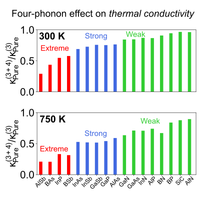当前位置:
X-MOL 学术
›
Phys. Rev. X
›
论文详情
Our official English website, www.x-mol.net, welcomes your
feedback! (Note: you will need to create a separate account there.)
Phonon-Phonon Interactions in Strongly Bonded Solids: Selection Rules and Higher-Order Processes
Physical Review X ( IF 11.6 ) Pub Date : 2020-06-18 , DOI: 10.1103/physrevx.10.021063 Navaneetha K. Ravichandran , David Broido
Physical Review X ( IF 11.6 ) Pub Date : 2020-06-18 , DOI: 10.1103/physrevx.10.021063 Navaneetha K. Ravichandran , David Broido

|
We show that the commonly used lowest-order theory of phonon-phonon interactions frequently fails to accurately describe the anharmonic phonon decay rates and thermal conductivity (), even among strongly bonded crystals. Applying a first-principles theory that includes both the lowest-order three-phonon and the higher-order four-phonon processes to 17 zinc blende semiconductors, we find that the lowest-order theory drastically overestimates the measured for many of these materials, while inclusion of four-phonon scattering gives significantly improved agreement with measurements. We identify new selection rules on three-phonon processes that help explain many of these failures in terms of anomalously weak anharmonic phonon decay rates predicted by the lowest-order theory competing with four-phonon processes. We also show that zinc blende compounds containing boron (B), carbon (C), or nitrogen (N) atoms have exceptionally weak four-phonon scattering, much weaker than in compounds that do not contain B, C, or N atoms. This new understanding helps explain the ultrahigh in several technologically important materials like cubic boron arsenide, boron phosphide, and silicon carbide. At the same time, it not only makes the possibility of achieving high in materials without B, C, or N atoms unlikely, but it also suggests that it may be necessary to include four-phonon processes in many future studies. Our work gives new insights into the nature of anharmonic processes in solids and demonstrates the broad importance of higher-order phonon-phonon interactions in assessing the thermal properties of materials.
中文翻译:

强键合固体中的声子-声子相互作用:选择规则和高阶过程
我们证明了常用的声子-声子相互作用的最低阶理论经常无法准确地描述非谐声子的衰减率和热导率(),即使在牢固结合的晶体中也是如此。将包括最低阶三声子过程和较高阶四声子过程的第一原理理论应用于17种锌共混物半导体,我们发现最低阶理论极大地高估了测得的对于许多这些材料,同时包含四声子散射可以显着改善与测量的一致性。我们确定了关于三声子过程的新选择规则,这些规则根据最低阶理论与四声子过程竞争所预测的异常弱的非谐声子衰变率来帮助解释许多此类失败。我们还显示,含硼(B),碳(C)或氮(N)原子的锌共混物具有极弱的四声子散射,比不包含B,C或N原子的化合物弱得多。这种新的理解有助于解释超高在一些技术上重要的材料中,例如立方砷化硼,磷化硼和碳化硅。同时,它不仅使实现高不含B,C或N原子的材料的可能性很小,但这也表明在将来的许多研究中可能有必要包括四声子过程。我们的工作为固体中非谐过程的性质提供了新的见解,并证明了高阶声子-声子相互作用在评估材料的热性能方面的广泛重要性。
更新日期:2020-06-18
中文翻译:

强键合固体中的声子-声子相互作用:选择规则和高阶过程
我们证明了常用的声子-声子相互作用的最低阶理论经常无法准确地描述非谐声子的衰减率和热导率(),即使在牢固结合的晶体中也是如此。将包括最低阶三声子过程和较高阶四声子过程的第一原理理论应用于17种锌共混物半导体,我们发现最低阶理论极大地高估了测得的对于许多这些材料,同时包含四声子散射可以显着改善与测量的一致性。我们确定了关于三声子过程的新选择规则,这些规则根据最低阶理论与四声子过程竞争所预测的异常弱的非谐声子衰变率来帮助解释许多此类失败。我们还显示,含硼(B),碳(C)或氮(N)原子的锌共混物具有极弱的四声子散射,比不包含B,C或N原子的化合物弱得多。这种新的理解有助于解释超高在一些技术上重要的材料中,例如立方砷化硼,磷化硼和碳化硅。同时,它不仅使实现高不含B,C或N原子的材料的可能性很小,但这也表明在将来的许多研究中可能有必要包括四声子过程。我们的工作为固体中非谐过程的性质提供了新的见解,并证明了高阶声子-声子相互作用在评估材料的热性能方面的广泛重要性。











































 京公网安备 11010802027423号
京公网安备 11010802027423号